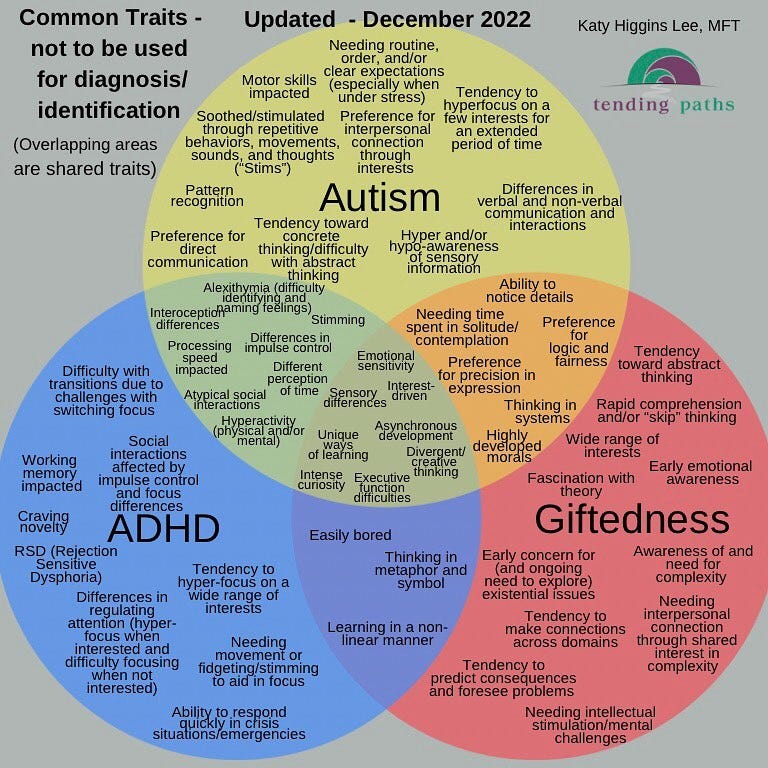In episode 30, Chris and Emma were joined by Katy Higgins Lee, MFT, a therapist and clinical supervisor in private practice in Santa Rosa, California. She works with neurodivergent adults with a focus on giftedness and twice-exceptionality. This episode is our contribution to Neurodiversity Celebration Week, March 13-19, 2023.
We kicked the episode off by defining neurodiversity with a quote:
“Neurodiversity is the diversity of human minds, the infinite variation in neurocognitive functioning within our species.” Dr. Nick Walker
We learned about the terms neurodiversity and neurodivergence, and the appropriate application for individuals compared to groups. Katy talked about the way that neurodivergence can be either innate (e.g., ADHD, autism) or acquired (e.g., PTSD, traumatic brain injury).
We asked Katy the question, Is giftedness a type of neurodivergence? We agreed with her that giftedness is more than an IQ score, and fits the definition of neurodivergence since this is an experience of reality that diverges from what can be considered typical. Asynchronous development was mentioned, which is a definition of giftedness from the Columbus Group that incorporates the overexcitabilities:
“Giftedness is asynchronous development in which advanced cognitive abilities and heightened intensity combine to create inner experiences and awareness that are qualitatively different from the norm. This asynchrony increases with higher intellectual capacity. The uniqueness of the gifted renders them particularly vulnerable and requires modifications in parenting, teaching and counseling in order for them to develop optimally.” Columbus Group, 1991
Katy discussed being neurodiversity-affirming and non-pathologizing. We learned that we can view these differences as identities or neurotypes, rather than disorders or disadvantages. This perspective is not meant to minimize disability, but we are taking the perspective of the social model of disability rather than the medical model. We talked about the fact that giftedness is not the advantage or blessing people may assume.
Neurodiversity-affirming means using identify-first language rather than person-first language. For instance, autistic person rather than person with autism. We also talked about not using functioning labels such as “high-functioning” vs “low-functioning” autism and instead considering differences in support needs.
It’s also critical to be trauma-informed and LGBTQ+-affirming. Katy said it’s especially important to remember the need to be trans-affirming as part of a neurodiversity-affirmative practice because many neurodivergent people are also trans, nonbinary, or otherwise gender non-conforming.
We discussed overexcitabilities being part of the gifted experience, and the autistic and ADHD experience, and how that wasn’t clear from Katy’s introduction to OEs in the gifted community. Chris had a similar experience, and they shared a little about their work to figure out if OE was really something different from ADHD or autism. Chris feels it’s time to change the narrative and help the gifted world catch up—OEs are a part of the neurodivergent experience beyond the connection with giftedness.
Katy pointed out that the term giftedness is losing credibility in the neurodiversity community partly due to OEs not being seen as types of neurodivergence, which can hinder people on their journey of self-discovery. It’s not an either/or proposition of OE or ADHD (or autism). Missed identification of neurodivergence types in gifted individuals is a cause of trauma for many.
We talked about the overlap between ADHD and autism, as well as the way that other differences seem closely connected such as giftedness, gender differences, Ehlers-Danos Syndrome, and OCD. Last year, Katy created a diagram based on the overlap between ADHD, autism, and giftedness, which we’ve included below.

(This diagram was updated by Katy after the episode was recorded.)
We discussed how stereotypes about ADHD, autism, and giftedness, and even their names, have caused problems in understanding these experiences. Giftedness is a term with a lot of misconceptions, but it is an important difference to acknowledge and understand. Even though parents of gifted children are often gifted themselves, they don’t necessarily see it in themselves or recognize its impact on their lives. Intergenerational trauma was mentioned as one of the factors that must be talked about and addressed in order to shift the patterns that hold us back.
Links for this episode
Katy’s Tending Paths accounts on Facebook and Instagram.
Katy’s website
Katy will be joining us as a presenter at the 2024 Dabrowski Congress! Click here for more information.
Dr. Nick Walker’s website
The Origins and Conceptual Evolution of Overexcitability
Autism as a Disorder of High Intelligence
Emma’s video on looking at the tiger (Integrating Perspectives, YouTube)
Types of Increased Psychic Excitability by K. Dabrowski (PDF)
Giftedness: The View Within by M. Morelock (PDF). We’ve included this paper because it’s where asynchronous development made its debut in 1992. The book Off the Charts by Neville et al. is a great place to learn more about asynchrony and giftedness.
Connect with us!
Positive Disintegration on Substack
Visit the Dabrowski Center website
The Positive Disintegration YouTube Channel
Adults with Overexcitabilities group on Facebook
Dabrowski Center and Positive Disintegration Podcast Community on Facebook
The Tragic Gift blog by Emma
Email us at positivedisintegration.pod@gmail.com
Please consider supporting the podcast to help fund this work through the Dabrowski Center, a 501(c)(3) nonprofit organization.
Find Positive Disintegration Merch
If you enjoyed this episode on Apple or Spotify, please remember to click on the stars and leave a rating or write a review. Thank you! <3















Celebrating Neurodiversity, Overexcitabilities, and Giftedness